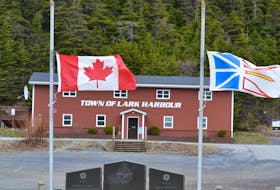Still with its new ship smell, spotless interior and a proud crew at the helm, the Canadian Coast Guard Ship Pennant Bay powered out of St. John’s harbour on a sunny, warm Wednesday morning for an at-sea training drill with a Cormorant helicopter from 103 Search and Rescue Squadron out of 9 Wing Gander.
The Pennant Bay lifeboat is one of three 62-foot bay-class vessels to be stationed in the province to replace aging vessels. The Pennant Bay is the first out of the shop.
Its modern design, speed, maneuverability and self-righting capability makes it a better and safer vessel that can take on more of what the North Atlantic can toss at it when on a search and rescue mission.
“She is capable of withstanding hurricane-force winds, seas up to 40 feet, and the vessel can do up to 25 knots in ideal conditions,” Commanding Officer Aaron Coffin said. “This vessel has more of a range, a bigger survivors’ compartment, more comfort, it’s a bigger vessel … just a more modern design. We can operate up to 120 nautical miles from shore and it is designed with tow winches. Basically, any long-liner that breaks down within our range we can tow them in to safe port, or take part in general search and rescue operations.
“She is solid and handles really well.”
The Pennant Bay put off an impressive display Wednesday, its powerful twin engines churning up the ocean as it showed off its turning and high-speed capabilities for media while awaiting the arrival of the Cormorant.
The Pennant Bay will be stationed at St. Anthony this fall as soon as renovations at the St. Anthony lifeboat station are completed. The ship has a crew of four — commanding officer, engineer and two deckhands — who will work on a two-week rotation.
Bay-class vessels currently under construction will also be assigned to newly constructed lifeboat stations at Twillingate and Old Pelican in 2019.
As the Cormorant approached Wednesday, the Pennant Bay headed into the wind and matched speed with the Cormorant. Three search and rescue technicians and a stretcher were lowered to the Pennant Bay’s stern amid the noise and sea mist kicked up by the helicopter.
“It will simulate the same thing as if in a real emergency,” Coffin said of the exercise. “If we were to pick somebody up who was in trouble, we would take them onboard and a tech would take him off of the vessel.”
Neil Peet, deputy superintendent of search and rescue, Canadian Coast Guard Atlantic Region, described the Pennant Bay — named after a bay in Nova Scotia — as a great news story for the Canadian Coast Guard and all Canadians.
“The Government of Canada’s Ocean Protection Plan initiative — a $1.5-billion initiative — of which part of that is the new lifeboat program in which we are building seven new search and rescue stations across Canada, three of which are in Newfoundland and Labrador,” Peet said. “We are refurbishing our station in St. Anthony, and also building new stations in Twillingate and Old Pelican. This whole initiative for the lifeboats is a $105-million capital investment with ongoing annual investment of $12 million, and we are looking at 56 new jobs across Canada.”
Peet said search and rescue is not about the Canadian Coast Guard or the Royal Canadian Air Force, but about bringing the “right assets to bear at the right place at the right time to save lives.”
“The lifeboat program is one line of defence the Canadian Coast Guard and federal search and rescue system offers,” he said. “It’s a wonderful asset to locate in the St. Anthony area for rapid high-speed response to risk in the area, particularly to fishing vessels.”








